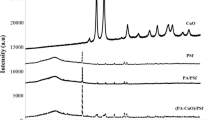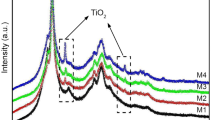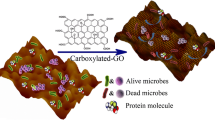Abstract
In situ formation of a Cu-(m-phenylenediamine) (Cu-mPD) oligomer complex from copper chloride during the interfacial polymerization process was successfully employed to produce modified thin-film composite reverse osmosis membranes (TFC-RO) with antibiofouling properties. Membranes were characterized by field emission scanning electron microscopy, Fourier transform infrared spectroscopy (FTIR), X-ray photoelectron spectroscopy (XPS), X-ray diffraction (XRD), atomic force microscopy, and contact angle measurements. Antibiofouling properties were studied using a colony-forming unit test with Escherichia coli. Moreover, an antiadhesion test was developed using fluorescence microscopy. Membrane performance using a cross-flow cell was evaluated, and copper concentration in permeate water was measured. FTIR, XPS and XRD results confirmed the formation of a Cu-mPD oligomer complex and its incorporation into the polyamide layer. A mechanism for formation of the oligomer within the membrane was proposed based on the interaction between the oxygen of the carbonyl group of the polyamide layer and copper ion of the Cu-mPD oligomer complex. The modified membrane showed a slight decrease in hydrophilicity and higher surface roughness. However, excellent antibacterial and antiadhesion effects were observed, attributed to copper toxicity as a result of Cu2+ ions release from the membrane surface. Release of copper ions in the permeate water was determined, and the maximum value observed was considered negligible according to the World Health Organization. The desalination performance of modified membrane showed an important salt rejection with stable water flux. In conclusion, a novel chemical method for the incorporation of Cu-mPD oligomer complex into the polyamide layer of TFC-RO membranes to improve their antibiofouling properties and desalination performance was achieved.








Similar content being viewed by others
References
Kang GD, Cao YM (2012) Development of antifouling reverse osmosis membranes for water treatment: a review. Water Res 46:584–600
Buonomenna MG (2013) Nano-enhanced reverse osmosis membranes. Desalination 314:73–88
Subramani Arun, Jacangelo Joseph G (2015) Emerging desalination technologies for water treatment: a critical review. Water Res 75:164–187
Gohil Jaydevsinh M, Ray Paramita (2017) A review on semi-aromatic polyamide TFC membranes prepared by interfacial polymerization: potential for water treatment and desalination. Sep Purif Technol 181:159–182
Ghosh AK, Bindal RC, Prabhakar S, Tewari PK (2011) Composite polyamide reverse osmosis (RO) membranes—recent developments and future directions technology development. BARC Newsl 321:43–51
Jiang Shanxue, Li Yuening, Ladewig Bradley P (2017) A review of reverse osmosis membrane fouling and control strategies. Sci Total Environ 595:567–583
Karkhanechi H, Razi F, Sawada I, Takagi R, Ohmukai Y, Matsuyam H (2013) Improvement of antibiofouling performance of a reverse osmosis membrane through biocide release and adhesion resistance. Sep Purif Technol 105:106–113
Asatekin A, Mayes AM (2009) Oil industry wastewater treatment with fouling resistant membranes containing amphiphilic comb copolymers. Environ Sci Technol 43:4487–4492
Ong CS, Goh PS, Lau WJ, Misdan N, Ismail AF (2016) Nanomaterials for biofouling and scaling mitigation of thin film composite membrane: a review. Desalination 393:2–15
Kang GD, Cao YM (2012) Development of antifouling reverse osmosis membranes for water treatment: a review. Water Res 46:584–600
Buonomenna MG (2013) Nano-enhanced reverse osmosis membranes. Desalination 314:73–88
Guo-Rong Xu, Wang Jiao-Na, Li Cong-Ju (2013) Strategies for improving the performance of the polyamide thin film composite (PA-TFC) reverse osmosis (RO) membranes: surface modifications and nanoparticles incorporations. Desalination 328:83–100
Lia Xin, Sotto Arcadio, Li Jiansheng, Van der Bruggen Bart (2017) Progress and perspectives for synthesis of sustainable antifouling composite membranes containing in situ generated nanoparticles. J Membr Sci 524:502–528
Kango S, Kaliab S, Celli A, Njugunad J (2013) Surface modification of inorganic nanoparticles for development of organic–inorganic nanocomposites—a review. Prog Polym Sci 38:1232–1261
Kim J, Van der Bruggen B (2010) The use of nanoparticles in polymeric and ceramic membrane structures: review of manufacturing procedures and performance improvement for water treatment. Environ Pollut 158:2335–2349
Goh PS, Ismail AF (2015) Review: Is interplay between nanomaterial and membrane technology the way forward for desalination? J Chem Technol Biotechnol 90:971–980
Goh PS, Ismail AF, Hilal N (2016) N Nano-enabled membranes technology: sustainable and revolutionary solutions for membrane desalination? Desalination 380:100–104
Karkhanechi H, Razi F, Sawada I, Takagi R, Ohmukai Y, Matsuyam H (2013) Improvement of antibiofouling performance of a reverse osmosis membrane through biocide release and adhesion resistance. Sep Purif Technol 105:106–113
Ben-Sasson M, Zodrow K, Genggeng Q, Kang Y, Giannelis E, Elimelech M (2014) Surface functionalization of thin-film composite membranes with copper nanoparticles for antimicrobial surface properties. Environ Sci Technol 48:384–393
Banerjee I, Pangule RC, Kane RS (2011) Antifouling coatings: recent developments in the design of surfaces that prevent fouling by proteins, bacteria, and marine organisms. Adv Mater 23:690–718
Cioffi N, Torsi L, Ditaranto N, Tantillo G, Ghibelli L, Sabbatini L, Bleve-Zacheo T, D’Alessio M, Zambonin P, Traversa E (2005) Copper nanoparticle/polymer composites with antifungal and bacteriostatic properties. Chem Mater 17:5255–5262
Chapman JS (2003) Biocide resistance mechanisms. Int Biodeterior Biodegradation 51:133–138
Bagchi B, Dey S, Bhandary S, Das S, Bhattacharya A, Basu R, Nandy P (2012) Antimicrobial efficacy and biocompatibility study of copper nanoparticle adsorbed mullite aggregates. Mater Sci Eng C32:1897–1905
Ren G, Hu D, Cheng EW, Vargas-Reus MA, Reip P, Allaker RP (2009) Characterisation of copper oxide nanoparticles for antimicrobial applications. Int J Antimicrob Agents 33:587–590
Baek YW, An YJ (2011) Microbial toxicity of metal oxide nanoparticles (CuO, NiO, ZnO, and Sb2O3) to Escherichia coli, Bacillus subtilis, and Streptococcus aureus. Sci Total Environ 409:1603–1608
Bondarenko O, Juganson K, Ivask A, Kasemets K, Mortimer M, Kahru A (2009) Toxicity of nanoparticles of CuO, ZnO and TiO2 to microalgae Pseudokirchneriella subcapitata. Sci Total Environ 407:1461–1468
Shaffiey SF, Bozorgnia A, Ahmad M (2014) Synthesis and evaluation of bactericidal properties of CuO nanoparticles against Aeromonas hydrophila. Nanomed J 1:98–204
García A, Quintero Y, Vicencio N, Rodríguez B, Ozturk D, Mosquera E, Corrales TP, Volkmannf Elimelech UG (2016) Influence of TiO2 nanostructures on anti-adhesion and photoinduced bactericidal properties of thin film composite membranes. RSC Adv 6:82941–82948
Akar N, Asar B, Dizge N, Koyuncu I (2013) Investigation of characterization and biofouling properties of PES membrane containing selenium and copper nanoparticles. J Membr Sci 437:216–226
Isloor A, Ganesh BM, Isloor S, Ismail AF, Nagaraj HS, Pattabi M (2013) Studies on copper coated polysulfone/modified poly isobutylene alt-maleic anhydride blend membrane and its antibiofouling property. Desalination 308:82–88
Baghbanzadeh M, Rana D, Matsuura T, Lan C (2015) Effects of hydrophilic CuO nanoparticles on properties and performance of PVDF VMD membranes. Desalination 369:75–84
Ben-Sasson M, Lu X, Nejati S, Jaramillo H, Elimelech M (2016) In situ surface functionalization of reverse osmosis membranes with biocidal copper nanoparticles. Desalination 38:1–8
Hausman R, Gullinkala T, Escobar IC (2010) Development of copper-charged polypropylene feedspacers for biofouling control. J Membr Sci 35:114–121
Hausman R, Gullinkala T, Escobar IC (2009) Development of low-biofouling polypropylene feedspacers for reverse osmosis. J Appl Polym Sci 114:3068–3073
Xu J, Feng X, Chen P, Gao C (2012) Development of an antibacterial copper (II)-chelated polyacrylonitrile ultrafiltration membrane. J Membr Sci 413–414:62–69
Asapu S, Pant S, Gruden CL, Escobar IC (2014) An investigation of low biofouling copper-charged membranes for desalination. Desalination 338:17–25
Garcia A, Rodríguez B, Oztürk D, Rosales M, Paredes C, Cuadra F, Montserrat S (2016) Desalination performance of antibiofouling reverse osmosis membranes. Mod Environ Sci Eng 2:481–489
García A, Rodríguez B, Oztürk D, Rosales M, Diaz DI, Mautner A (2017) Incorporation of CuO nanoparticles into thin-film composite reverse osmosis membranes (TFC-RO) for antibiofouling properties. Polym Bull 46:1–17
Zhang L, Wang H, Yu W, Su Z, Chai L, Li J, Shi Y (2012) Facile and large-scale synthesis of functional poly(m-phenylenediamine) nanoparticles by Cu2+-assisted method with superior ability for dye adsorption. J Mater Chem 22:18244–18251
Da S, Peng B, Zhang L, Chai L, Wang T, Meng Y, Li X, Wang H, Luo J (2015) Sustainable synthesis of hollow Cu-loaded poly(m-phenylenediamine) particles and their application for arsenic removal. RSC Adv 5:29965–29974
Chai L, Wang T, Zhang L, Wang H, Yang W, Dai S, Meng Y, Li X (2015) A Cu–m-phenylenediamine complex induced route to fabricate poly(m-phenylenediamine)/reduced graphene oxide hydrogel and its adsorption application. Carbon 81:748–757
Rahimpour A, Madaeni SS, Taheri AH, Mansourpanah Y (2008) Coupling TiO2 nanoparticles with UV irradiation for modification of polyethersulfone ultrafiltration membranes. J Membr Sci 313:158–169
Saleh TA, Gupta VK (2012) Synthesis and characterization of alumina nano-particles polyamide membrane with enhanced flux rejection performance. Sep Purif Technol 89:245–251
Zhang M, Zhang K, De Gusseme B, Verstraete W (2012) Biogenic silver nanoparticles (bio-Ag 0) decrease biofouling of bio-Ag 0/PES nanocomposite membranes. Water Res 46(7):2077–2087
Lee HS, Im SJ, Kim JH, Kim HJ, Kim JP, Min BR (2008) Polyamide thin-film nanofiltration membranes containing TiO2 nanoparticles. Desalination 219(1–3):48–56
Tang CY, Kwon Y-N, Leckie JO (2009) Effect of membrane chemistry and coating layer on physiochemical properties of thin film composite polyamide RO and NF membranes: I. FTIR and XPS characterization of polyamide and coating layer chemistry. Desalination 242:149–167
Akin O, Temelli F (2011) Probing the hydrophobicity of commercial reverse osmosis membranes produced by interfacial polymerization using contact angle, XPS, FTIR, FE-SEM and AFM. Desalination 278:387–396
Robert FXW, Silverstein M, Kiemle D (2005) Spectrometric identification of organic compounds, 7th edn. Wiley, New York
Khorshidi B, Soltannia B, Thundat T, Sadrzadeh M (2017) Synthesis of thin film composite polyamide membranes: effect of monohydric and polyhydric alcohol additives in aqueous solution. J Membr Sci 523:336–345
Hoof DL, Tisley DG, Walton RA (1973) Studies on metal carboxylates. Part III. Pyridine-2,6-dicarboxylates of the lanthanides. Synthesis and spectral studies and the X-ray photoelectron spectra of several pyridine carboxylate complexes. J Chem Soc, Dalton Trans 2:200–204
Zhang LY, Chai LY, Liu J, Wang HY, Yu WT, Sang PL (2011) pH manipulation: a facile method for lowering oxidation state and keeping good yield of poly (m-phenylenediamine) and its powerful Ag + adsorption ability. Langmuir 27:13729–13738
Wagner CD, Riggs WM, Davis LE, Moulder JF, Muilenberg GE (1979) Handbook of X-ray photoelectron spectroscopy, vol 190. Perkin-Elmer Corporation, Waltham
Liu Zhirong Md, Uddin Azhar, Zhanxue Sun (2011) FT-IR and XRD analysis of natural Na-bentonite and Cu(II)-loaded Na-bentonite, Spectrochim. Acta Part A 79:1013–1016
Porter MC (1991) Handbook of industrial membrane technology. Noyes Publications, Saddle River
Kwak SGJSY, Yoon YS, Ihm DW (1999) Details of surface features in aromatic polyamide reverse osmosis membranes characterized by scanning electron and atomic force microscopy. J Polym Sci, Part B: Polym Phys 37:1429–1440
Jia Xu, Zhang Lili, Gao Xueli, Bie Haiyan, Yunpeng Fu, Gao Congjie (2015) Constructing antimicrobial membrane surfaces with polycation-copper (II) complex assembly for efficient seawater softening treatment. J Membr Sci 494:28–36
Lupsea Maria, Mathies Helena, Schoknecht Ute, Tiruta-Barna Ligia, Schiopu Nicoleta (2013) Biocide leaching from CBA treated wood—a mechanistic interpretation. Sci Total Environ 444:522–530
Nadraroglu H, Kalkan E, Demir N (2010) Removal of copper from aqueous solution using red mud. Desalination 251:90–95
Acknowledgements
The authors gratefully acknowledge financial support provided by National Fund for Scientific and Technological Development (FONDECYT) of the Government of Chile (Project No. 11130251). The authors thank Solvay Advanced Polymers for donating the polysulfone Udel P-1700. The authors also thank to the Water Quality Laboratory of the Department of Civil Engineering of Universidad de Chile for giving the infrastructure and the technician Viviana Lorca for TOC measures made.
Funding
This study was funded by National Fund for Scientific and Technological Development (FONDECYT) of the Government of Chile (Grant No. 11130251).
Author information
Authors and Affiliations
Corresponding author
Ethics declarations
Conflict of interest
The authors declare that they have not conflict of interest.
Electronic supplementary material
Below is the link to the electronic supplementary material.
Rights and permissions
About this article
Cite this article
Rodríguez, B., Oztürk, D., Rosales, M. et al. Antibiofouling thin-film composite membranes (TFC) by in situ formation of Cu-(m-phenylenediamine) oligomer complex. J Mater Sci 53, 6325–6338 (2018). https://doi.org/10.1007/s10853-018-2039-4
Received:
Accepted:
Published:
Issue Date:
DOI: https://doi.org/10.1007/s10853-018-2039-4




